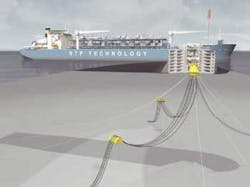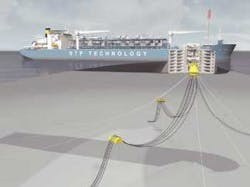Norwegian designer sees new production opportunities in GoM
The US market is coming into sharp focus for Advanced Production and Loading as it prepares to make its first delivery to the Gulf of Mexico. The acceptance by the regulatory authorities of both FPSOs and offshore oil loading also opens up new opportunities for the company.
null
APL is best known as the supplier of submerged turret loading (STL) and submerged turret production (STP) technology, and for the single anchor loading (SAL) system. Its merger last year with Hitec Marine brought new loading and discharge products on board, as well as a volatile organic compounds capture system, according to Marketing Manager Fredrik Major.
The company is involved in El Paso's energy bridge plan to enable natural gas to be transferred directly ashore from a vessel to the gas pipeline network, thus eliminating the need for onshore LNG storage and regasification facilities.
APL is to supply the STL buoy for the first energy bridge, to be built off the Louisiana coast and due to come into operation next year. These buoys are based on a standard STL design adapted for high-pressure gas transfer, says Major.
The major benefit of the STL concept, whereby a tanker connects to the submerged turret through the bottom of its hull, is that loading operations can continue in extremely bad weather conditions. The system has been in use on the Heidrun field in the Norwegian Sea since 1995, during which more than 650 loadings of shuttle tankers have taken place with a regularity of more than 99.9%, Major says. Even when conditions equivalent to a 100-year storm arose in November 2001, loading was able to continue.
In an FPSO context, use of the STP system enables quick disconnection, making the system appropriate for regions subject to hurricanes and other violent climatic phenomena. In the typhoon-prone South China Sea, the location of three STP systems, the experience with disconnection has been good.
Experience with the technology off China is directly relevant to the hurricane-prone Gulf of Mexico, where disconnectability is clearly an issue for FPSOs, Major says. However, whereas three to four hours is allowed for disconnecting in the South China Sea, the time required for this operation can be reduced to just 15 min. This will be possible through use of a remote automated system, Major says.
Deepwater is also an issue in the GoM, and APL has further developed the STP technology for such application, making improvements at component level, expanding the size of the buoy to accommodate more risers – 17 is the maximum considered so far – and adapting the system to handle higher pressures.
The SAL system, in which the tanker moors to a single anchor, which incorporates a swivel, is aimed at marginal fields. It provides a cheaper solution than the STL but with reduced operational limits. Two systems are now under construction for Tuscan's Ardmore development in the UK sector, in addition to the four already installed in the North Sea. Last autumn a SAL system specially developed for icy conditions was installed off Russia's north coast to allow tanker loading from a shore terminal in conditions of 60 cm of ice and -32° C.

